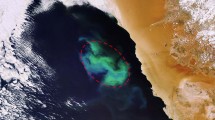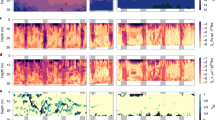Abstract
Diffusive processes are often used to represent the formation of spatial patterns in biological systems1. Here I show how patchiness may be generated in planktonic ecosystems through non-diffusive advection. Plankton distributions in oceanic surface waters can be characterized by the spectra of concentrations obtained along ship transects. Such spectra are inevitably found to have a power-law form over horizontal scales ranging from 1 to 100 km (ref. 2). Phytoplankton have distributions similar to those of physical quantities such as sea surface temperature, with much less variability at shorter length scales. In contrast, zooplankton density may be almost as variable at short scales as long ones3. Distributions of this form are generated in a model of the turbulent stirring of coupled phytoplankton and zooplankton populations. The characteristic spatial patterns of the phytoplankton and zooplankton are a consequence of the timescales of their response to changes in their environment caused by turbulent advection.
This is a preview of subscription content, access via your institution
Access options
Subscribe to this journal
Receive 51 print issues and online access
$199.00 per year
only $3.90 per issue
Buy this article
- Purchase on Springer Link
- Instant access to full article PDF
Prices may be subject to local taxes which are calculated during checkout




Similar content being viewed by others
References
Okubo, A. Biomathematics Vol. 10 , Diffusion and Ecological Problems: Mathematical Models (Springer, Berlin, 1980).
Mackas, D. L. & Boyd, C. M. Spectral analysis of zooplankton spatial heterogeneity. Science 204, 62–64 (1979).
Tsuda, A., Sugisaki, H., Ishimaru, T., Saino, T. & Sato, T. White-noise-like distribution of the oceanic copepod Neocalanus cristatus in the subarctic North Pacific. Mar. Ecol. Prog. Ser. 97, 39–46 (1993).
Okubo, A. Oceanic diffusion diagrams. Deep Sea Res. 18, 789–802 (1971).
Levin, S. A. & Segel, L. A. Hypothesis for origin of plankton patchiness. Nature 259, 659 (1976).
Wroblewski, J. S. & O'Brien, J. J. Aspatial model of phytoplankton patchiness. Mar. Biol. 35, 161–175 (1976).
Steele, J. H. & Henderson, E. W. Asimple model for plankton patchiness. J. Plankton Res. 14, 1397–1403 (1992).
Malchow, H. Nonequilibrium structures in plankton dynamics. Ecol. Model. 75/76, 123–134 (1994).
Parsons, T. R., Takahashi, M. & Hargrave, B. Biological Oceanographic Processes, 3rd edn (Pergamon, Oxford, 1984).
Kierstead, H. & Slobodkin, L. B. The size of water masses containing plankton blooms. J. Mar. Res. 12, 141–147 (1953).
Klein, P. & Hua, B. L. The mesoscale variability of the sea surface temperature: An analytical and numerical model. J. Mar. Res. 48, 729–763 (1990).
Kiorboe, T. & Sabatini, M. 1995 Scaling of fecundity, growth and development in marine planktonic copepods. Mar. Ecol. Prog. Ser. 120, 285–298 (1995).
Denman, K. L. & Platt, T. The variance spectrum of phytoplankton in a turbulent ocean. J. Mar. Res. 34, 593–601 (1976).
Gower, J. F. R., Denman, K. L. & Holyer, R. J. Phytoplankton patchiness indicates the fluctuation spectrum of mesoscale oceanic structure. Nature 288, 157–159 (1980).
Lesieur, M. & Sadourny, R. Satellite-sensed turbulent ocean structure. Nature 294, 673 (1981).
Bennett, A. F. & Denman, K. L. Phytoplankton patchiness: inferences from particle statistics. J. Mar. Res. 43, 307–335 (1985).
Holloway, G. Eddies, waves, circulation and mixing: statistical geofluid mechanics. Annu. Rev. Fluid Mech. 18, 91–147 (1986).
Powell, T. M. & Okubo, A. Turbulence, diffusion and patchiness in the sea. Phil. Trans. R. Soc. Lond. B 343, 11–18 (1994).
Dyke, P. P. G. & Robertson, T. The simulation of offshore turbulent dispersion using seeded eddies. Appl. Math. Model. 9, 429–433 (1985).
Trathan, P. N., Priddle, J., Watkins, J. L., Miller, D. G. M. & Murray, A. W. A. Spatial variabiity of Antarctic krill in relation to mesoscale hydrography. Mar. Ecol. Prog. Ser. 98, 61–71 (1993).
Renka, R. J. Triangulation and interpolation at arbitrarily distributed points in the plane. ACM Trans. Math. Software 10, 440–442 (1984).
Deschamps, P. Y., Frouin, R. & Wald, L. Satellite determinations of the mesoscale variability of the sea surface temperature. J. Phys. Oceanogr. 11, 864–870 (1981).
Mackas, D. L., Denman, K. L. & Abbot, M. R. Plankton patchiness: biology in the physical vernacular. Bull. Mar. Sci. 37, 652–674 (1985).
Smith, C. L., Richards, K. J. & Fasham, M. J. R. The impact of mesoscale eddies on plankton dynamics in the upper ocean. Deep Sea Res. I 43, 1807–1832 (1996).
Armi, L. & Flament, P. Cautionary remarks on the spectral interpretation of turbulent flows. J. Geophys. Res. C90, 11779–11782 (1985).
Piontkovski, S. A. et al. Spatial heterogeneity of the planktonic fields in the upper mixed layer of the open ocean. Mar. Ecol. Prog. Ser. 148, 145–154 (1997).
Fasham, M. J. R. in Spatial Pattern in Plankton Communities (ed. Steele, J. H.) 131–156 (Plenum, New York, 1978).
Gallagher, S. M., Davis, C. S., Epstein, A. W., Solow, A. & Beardsley, R. C. High-resolution observations of plankton spatial distributions correlated with hydrography in the Great South Channel, Geoges Bank. Deep Sea Res. II 43, 1627–1663 (1996).
Charney, J. G. Geostrophic turbulence. J. Atmos. Sci. 28, 1087–1095 (1971).
Middleton, J. F. Drifter spectra and diffusivities. J. Mar. Res. 43, 37–55 (1985).
Acknowledgements
I thank P. Boyd, P. Sutton, C. Stevens and J. Sharples for critical reading of the draft manuscript, and R. Renka for software made available through the TOMS internet archive that was used to interpolate the Lagrangian variables onto a regular grid.
Author information
Authors and Affiliations
Corresponding author
Rights and permissions
About this article
Cite this article
Abraham, E. The generation of plankton patchiness by turbulent stirring. Nature 391, 577–580 (1998). https://doi.org/10.1038/35361
Received:
Accepted:
Issue Date:
DOI: https://doi.org/10.1038/35361
This article is cited by
-
A Lagrangian model for drifting ecosystems reveals heterogeneity-driven enhancement of marine plankton blooms
Nature Communications (2023)
-
Bifurcation analysis in a diffusive phytoplankton–zooplankton model with harvesting
Boundary Value Problems (2021)
-
Fine-scale structures as spots of increased fish concentration in the open ocean
Scientific Reports (2021)
-
Change in rheotactic behavior patterns of dinoflagellates in response to different microfluidic environments
Scientific Reports (2021)
-
Chemotaxis under flow disorder shapes microbial dispersion in porous media
Nature Physics (2021)
Comments
By submitting a comment you agree to abide by our Terms and Community Guidelines. If you find something abusive or that does not comply with our terms or guidelines please flag it as inappropriate.



